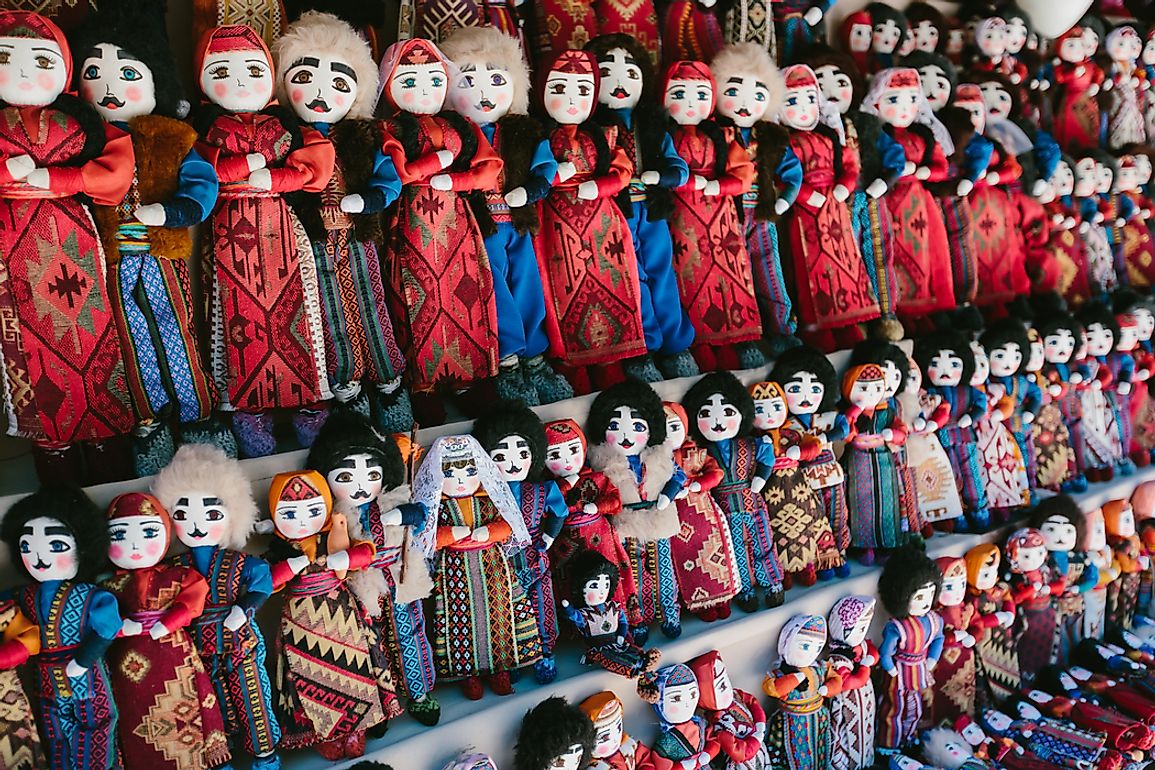The Armenian People and Armenian Culture

Armenian culture is that centered within the Republic of Armenia, located on the Caucasian Peninsula. The neighbouring peoples include the Georgians, the Azeris, the Iranians, and the Turks, with whom Armenians have strong cultural associations historically. The overwhelming majority of Armenians belong to the Armenian Apostolic Church, which is one of the constituent churches of the Oriental Orthodoxy, and one of the most ancient of all Christian denominations. Armenians also form a huge diaspora across Europe, Asia, and the Americas. The 8 million Armenians in the world abroad far outnumber the 3 million people residing in Armenia proper today.
Armenian Language
The Armenian language is one of the oldest languages of the Indo-European language group. It developed in the very earliest periods of Indo-European language differentiation. Due to long periods of dispersion and continuous commercial and military contacts, their language has been influenced by a host of neighbouring languages, particularly Turkish, Russian, and Persian. Significant dialectal variation exists between Armenian speakers, both within Armenia and across the people's diaspora. The Armenian written script was developed in the early 5th Century AD, originally consisting of 36 alphabetical figures, with three more figures later being incorporated into the alphabet from the Cyrillic script during the 19th Century. The spoken language developed with significant autonomy from the written language. Armenians are generally fluent with multiple languages depending on their location in the Armenian diaspora. Due to long periods of Russian rule, Russian is generally understood by most Armenians living in Armenia, as is English among the younger people who often study it in school settings.
Literature and Art
The earliest well-known Armenian literary works have been attributed to the 5th Century writer Moses of Khorene. Popular myths and heroic narratives had passed down the ages to form the basis for much of the early works, and in the process often underwent significant transformations. As the Armenian lands were for the most part divided among the powerful neighbouring empires of Russia, Turkey, and Persia, the Armenians developed a highly developed itinerant narrative tradition. In the 17th century, Alexander Tertzakian was a major literary figure, heralding the height of Armenian classical literature. Notable writers of the 19th and 20th Centuries included Levont Shant, Krikor Zohrab, Atrpet, and Nigol Aghpalian, among many others.
Armenia is known for its martial dance form of Yarkhusta. Armenian music is known for its seamless fusion, incorporating its own folk elements with Classical European and Middle Eastern musical forms alike. Listening to the Armenian Philharmonic Orchestra in Yerevan is an alluring tourist attraction, worthy of the attention of any visitor to the Armenian capital city of Yerevan.
Armenia has its own distinct carpet-designing traditions, as does its neighbor Iran. The traditional Armenian carpet, known as an Artsakh, is notable for its design schemes often featuring dragons and eagles, and is highly esteemed across the region. Armenia is noted for its distinct religious architecture as well. Early Armenian church construction was characterized by centralized Cupolas, to which niched buttresses were added from the 5th Century onward. These buttresses facilitated Armenian churches' distinctiveness, as did the utilization of design patterns from the Middle Eastern dome constructions and the extant European Medieval architectural trends.
Cuisine of Armenia
Armenian cuisine has a close affinity with Mediterranean styles, especially similar in comparison to those culinary traditions of its close neighbors in the Caucasus and the Middle East. Armenians' particular style of using spices with various types of vegetables, meat, and fishes gives their menu a distinctive flavor and aroma. Lavash bread is the traditional staple, which is considered as a symbol of Armenian culinary autonomy. Armenia also has its own unique brands of wine and brandy, such as the world famous Armenian cognac.
State of Armenian Culture Today
Armenia has been occupied by neighbouring empires throughout much of its history. As such, time and time again the culture faced threat of extinction or assimilation into other dominant cultures. However, with the establishment of the Armenian Republic in the wake of the dissolution of the Soviet Union, there were reasons for renewed confidence in the sustainability of one of the oldest extant cultures of our world. Armenian language and literature is being vigorously promoted among new first language speakers, both at home and across the global Armenian population. Still, the unique language faces a threat of language disintegration abroad. The Armenian people, unlike many other cultures, developed their traditions over a considerable period of time, over the course of which disparate communities had little contact with one another. The language diversified into a wide array of mutually unintelligible dialects. A lot of Armenians had also adopted the languages of dominant cultures in the new homes they settled within. The result has been low levels of Armenian language proficiency among members of the younger generations.







